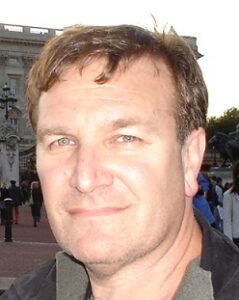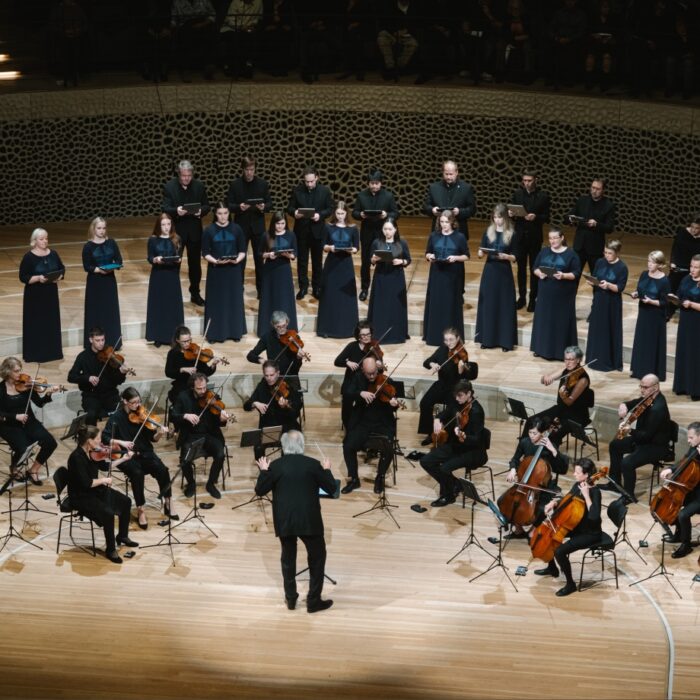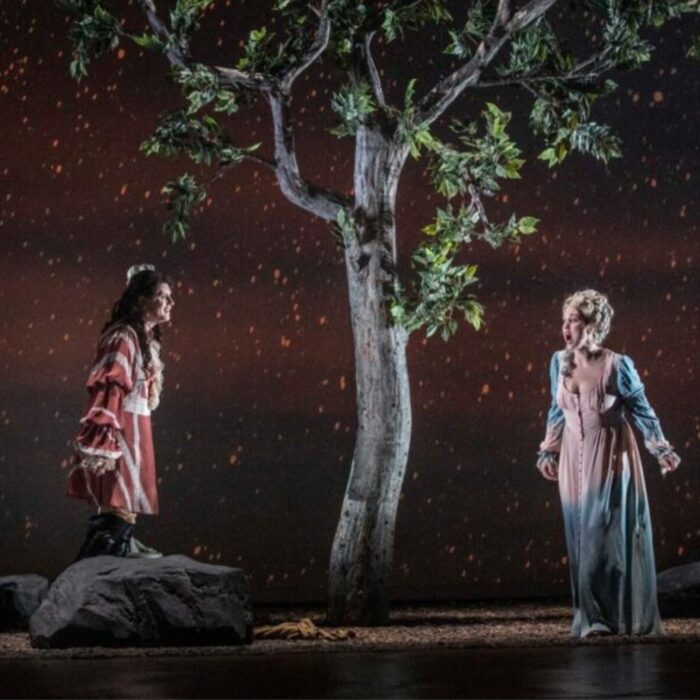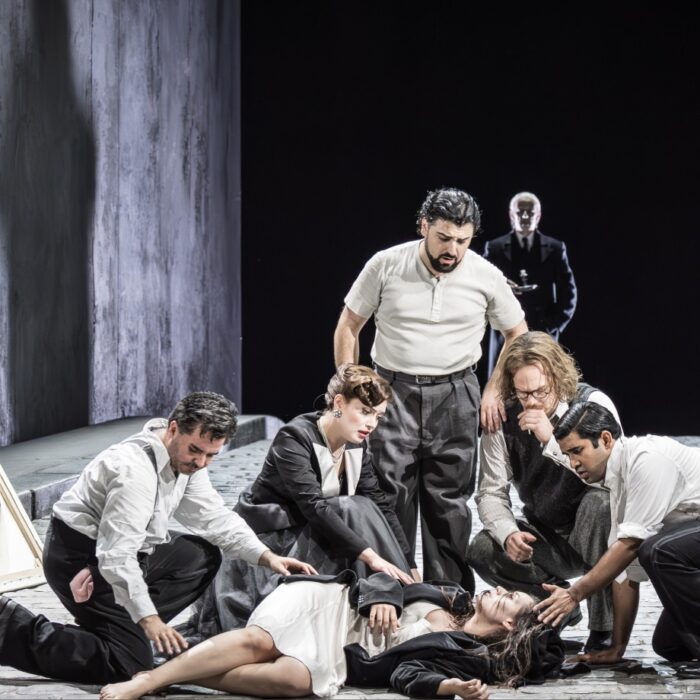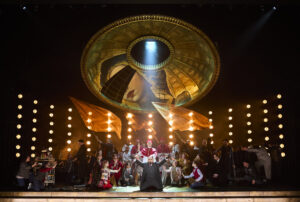
Opera Australia 2024 Review: Tosca
By Gordon Williams(Photo credit: Keith Saunders)
The program booklet for Opera Australia’s new production at Sydney Opera House of “Tosca”, an Opera North production, says that “Puccini set each act of his opera in three very specific locations which you can still visit today: the Sant’Andrea della Valle church in Rome, the Palazzo Farnese and the Castel Sant-Angelo over the River Tiber”.
UK director Edward Dick’s production, which premiered this season on June 25, “draws out all the drama and tension inherent in Puccini’s opera”, continues the booklet. “The design draws together contemporary imagery with Renaissance references, to create a timeless feel.”
How did all this work?
Production Highlights
Contemporary references consisted of Police Chief Scarpia’s goons talking into cuff-mic’s and Tosca’s Act two cantata, which takes place simultaneously with her lover Cavaradossi’s interrogation, coming through the laptop Scarpia has on his bed in the Palazzo Farnese. The offstage torture of the hero Cavaradossi, sung by South Korean tenor Young Woo Kim, was also relayed through the laptop as if captured on CCTV. As for Renaissance references, there was the dome of the church laid sideways as backdrop on which the final panel of Cavaradossi’s painting of the Magdalen would appear in Act three – the painting ironically complete in time for Cavaradossi’s own end. There was a sense of viewing things from multiple viewpoints in UK designer Tom Scutt’s sets. The votive candle racks from the church stayed on stage for Act two which took place in Scarpia’s bedroom. Was this a reminder that this evil character is only outwardly pious? Or maybe an indication of the claustrophobic proximity of Scarpia’s hypocrisy, since the candle racks shortened the depth of the stage.
But Puccini, often categorized as a verismo (realist) composer, was so insistent on realism when he wrote this work around the turn of the 20th century that he travelled to Rome to hear the effect of the various bells around the city from the ramparts of the Castel Sant-Angelo and their effect is reproduced in the score, beautifully played on June 25, it has to be said, by the Opera Australia Orchestra under German conductor Johannes Fritzsch (Conductor-Laureate of the Queensland Symphony Orchestra and former Chief Conductor of Oper Graz). Is this an opera that needs to be particularly realistic in order to work?
Dick’s conception seemed to show the work in comprehensible paragraphs that could be detected in the auditorium, an example being Cavaradossi’s verbal sparring with the Sacristan, Australian baritone Andrew Moran, that ends “He is utterfly unrepentant”, a dig at Cavaradossi’s lack of piety for one who’s been commissioned to paint the ceiling of a church. And there were some really informative examples of blocking. Scarpia, Armenian baritone Gevorg Hakobyan, lusting after Tosca and Tosca, Northern Irish soprano Giselle Allen, manipulating Scarpia because it’s not in her interest to get offside with him, almost got as close to each other as to kiss at one phrase-end, an apt illustration of the danger this lecher poses to Tosca who will ultimately need to bargain sex to get her lover Cavaradossi spared by this representative of a loathed regime.
Illuminating Symbolism
Bits of business such as Scarpia dusting off a place for Tosca to sit – next to him – nicely underscored comments people have made about Puccini’s ability to write music that accounts for stage business. But there were other decisions whose success might be questionable. Why did Spoletta, Australian tenor Benjamin Rasheed, crawl along Scarpia’s bed bench to report on progress with the suspect, Cavaradossi? Are Scarpia’s men in something-other-than-political thrall to him? Or was it simply serpentine symbolism? Note: the libretto specifies that Act two is set in Scarpia’s apartment with a table set for supper. Dick placed it directly in Scarpia’s bedroom, from which Cavaradossi’s cries from the torture chamber could be heard.
Such actions raised questions for me about how much clearer this interpretation made Puccini’s account of Scarpia’s opportunistic pursuit of Cavaradossi in order to exterminate his political enemy while clearing the way for seduction of Cavaradossi’s lover, Tosca.
Puccini’s work can be considered to take place on a specific date. In fact, Victorien Sardou who wrote the play on which the opera is based, specified the action to begin June 17, 1800. That was based on the time the news would have taken to reach Rome about the Battle of Marengo which is announced in Act one – falsely as it turns out – as a victory of the old guard over the progressive Cavaradossi’s hero, Napoleon. Would a first-time attendee have gotten wise to these details or needed to? Of course, the sight of Scarpia and Tosca clambering over Scarpia’s bed heightens a sense of personal peril for Tosca, but how much might an audience twig to the political stakes?
“Tosca” might be the other example, to set beside “Rigoletto”, where the creators have nicely balanced personal and political objectives. Puccini’s librettist, Luigi Illica, has Cavaradossi recognize the prisoner whose escape sets this work in motion as “Angelotti! The consul of the deposed Roman republic.” Opera North’s surtitles had it as “Angelotti, freedom fighter for the deposed regime.” But ‘republic’ is more specific than ‘regime’ and I would argue, in the context of this opera, more to be sympathized with. Was significance sharpened by this?
But what about the music? It was arresting from the beginning as Lee Curran’s lights synchronized with Puccini’s foreboding opening chords. There were other nice lighting touches, particularly that dazzling blast from a whole bank of lights when Tosca entered. Like the lights around a make-up mirror they emphasized that the much-desired Tosca is a famous singer/actress.
Musical Moments to Savor
Conductor Johannes Fritzsch provided the production with a good pace from the orchestral pit and a consciousness of underlining and foreshadowing the drama. Musical moments to savor included that sheen of strings rising up under Cavaradossi’s “Recondita armonia” when he extols the power of art to uncannily harmonize the beauty of his model for the Magdalen, a woman who has come to the church each day, the Attavanti whom we never see, and his lover, Tosca. The ensemble of strings at the beginning of Act three with their echo of the Act one love duet and presentiment of Cavaradossi’s final aria “E lucevan le stelle”, and the orchestral cellos divided in four, was especially beautiful.
Young Woo Kim was a very satisfying Cavaradossi – moving in the long sweep of his melodies but giving attention to details. As Cavaradossi reflected that Tosca is the main focus of his thoughts: “il mio solo pensiero, Tosca, sei tu!” there was exciting specificity in the way Young broke off before delivering those final two words. Young’s final aria, “E lucevan le stelle” where Cavaradossi contemplates the life he has led before his forthcoming execution, reached sublime heights – an effective exposition of that quality noted in Puccini’s tenor arias as “disperato”.
Soprano Giselle Allen gave us acting of the caliber we might expect of the fabled La Tosca. There was touching vulnerability when she has seemingly acquiesced to Scarpia’s demands and begins her lament about having lived only for art totally undeserving of this subjugation, ‘Vissi d’arte’. Some of Allen’s most hair-raising moments were spoken, but interestingly the line Tosca delivers over Scarpia’s body after she’s stabbed him – “È avanti a lui tremava tutta Roma!” (Before him all Rome trembled) – sometimes spoken, was sung.
Gevorg Hakobyan as Scarpia dominated the stage with his presence. We could well believe Scarpia ruled Rome by fear, while Hakobyan conveyed a smooth charm complete with menace even in his casual questioning, as in Act two’s bedroom scene.
Australian bass David Parkin’s nervousness as the escapee, Angelotti was palpable. Opera North’s surtitles had him admit that “In my panic, I seem to see spies everywhere” (an effective translation of the line: “Nel terror mio stolto vedea ceffi di birro in ogni volto”). And then he undermined his own self-reassurance that no-one is there (“Nessuno”) with a nervous chuckle. Nice details all round. Overall impression?
Concluding Thoughts
In his book, “Subsequent Performance”, a celebration of the fact that theater thrives on ongoing interpretation and even reinterpretation, Jonathan Miller, suggests a guideline for how far to go in interpreting the canon. He suggests adhering to the deep structure. But of course, then there could be arguments about the deepest part of the “deep structure”. The question this production raised for me was: how much realism in the surface particulars should be preserved or pronounced?
